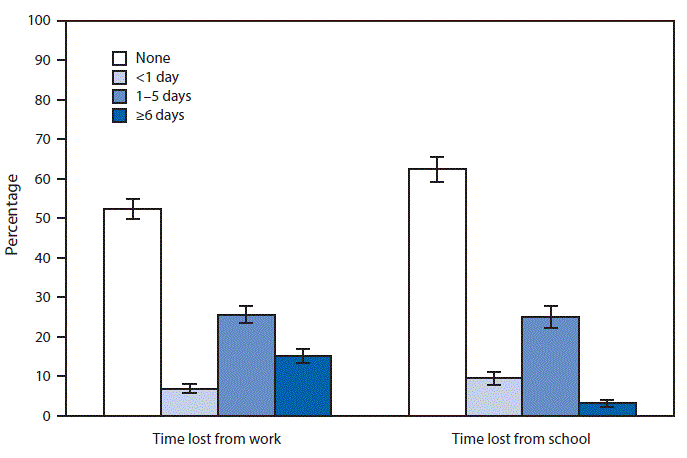QuickStats: Percentage* of Medically Attended Injury Episodes† That Resulted in Time Lost from Work§ or School,¶ by Number of Days Lost — National Health Interview Survey, United States, 2011–2014
Weekly / July 8, 2016 / 65(26);683

* With 95% confidence intervals.
† An injury episode refers to a trauma event resulting in damage to the body from an external cause. Estimates are for nonfatal, medically attended injuries occurring during the 5 weeks preceding the interview.
§ Time lost from work among persons aged ≥13 years who were employed at the time of injury.
¶ Time lost from school among students aged ≥5 years who attended school at the time of injury.
During 2011–2014, an average of 15.6 million medically attended injury episodes were reported annually among employed persons aged ≥13 years. Nearly half of these injury episodes resulted in time lost from work: 7% for <1 day, 26% for 1–5 days, and 15% for ≥6 days. An average of 9.4 million medically attended injury episodes were reported annually among persons aged ≥5 years who attended school. More than one third of these injury episodes resulted in time lost from school: 9% for <1 day, 25% for 1–5 days, and 3% for ≥6 days.
Source: National Health Interview Survey, 2011–2014 data. http://www.cdc.gov/nchs/nhis.htm.
Reported by: Yahtyng Sheu, PhD, ysheu@cdc.gov, 301-458-4354; Holly Hedegaard, MD.
Suggested citation for this article: QuickStats: Percentage of Medically Attended Injury Episodes That Resulted in Time Lost from Work or School, by Number of Days Lost — National Health Interview Survey, United States, 2011–2014. MMWR Morb Mortal Wkly Rep 2016;65:683. DOI: http://dx.doi.org/10.15585/mmwr.mm6526a5external icon.
MMWR and Morbidity and Mortality Weekly Report are service marks of the U.S. Department of Health and Human Services.
Use of trade names and commercial sources is for identification only and does not imply endorsement by the U.S. Department of
Health and Human Services.
References to non-CDC sites on the Internet are
provided as a service to MMWR readers and do not constitute or imply
endorsement of these organizations or their programs by CDC or the U.S.
Department of Health and Human Services. CDC is not responsible for the content
of pages found at these sites. URL addresses listed in MMWR were current as of
the date of publication.
All HTML versions of MMWR articles are generated from final proofs through an automated process. This conversion might result in character translation or format errors in the HTML version. Users are referred to the electronic PDF version (https://www.cdc.gov/mmwr) and/or the original MMWR paper copy for printable versions of official text, figures, and tables.
Questions or messages regarding errors in formatting should be addressed to mmwrq@cdc.gov.